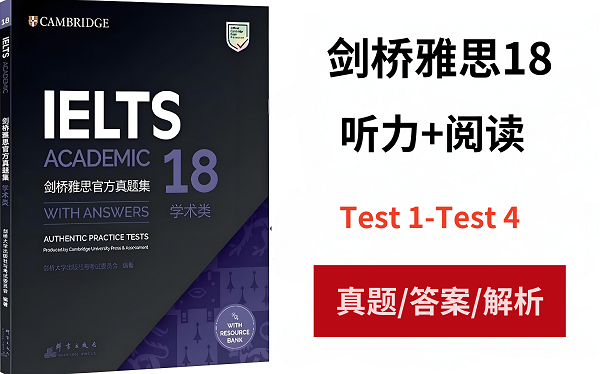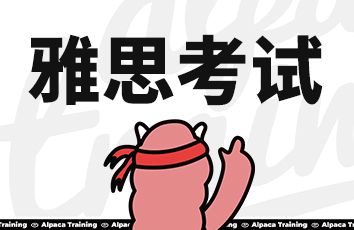剑桥雅思18阅读真题电子版Test3 Passage1
剑桥雅思18共收集了雅思真题4套,羊驼雅思整理了第三套阅读真题答案及解析Test 3 Reading,以下是阅读第一篇文章Passage1的文章原文,供烤鸭们复习参考。

剑桥雅思18听力和阅读真题答案及解析汇总查看剑桥雅思18真题答案解析汇总,为助力考生们备考雅思,羊驼雅思APP推出剑桥雅思真题及答案解析视频,可在羊驼雅思APP课程一栏获取剑雅系列视频信息。
READING PASSAGE 1
You should spend about 20 minutes on Questions 1-13. which are based on Reading Passage 1 below.
Materials to take us beyond concrete
Concrete is everywhere, but it's bad for the planet, generating large amounts of carbon dioxide-alternatives are being developed
A
Concrete is the second most used substance in the global economy, after water - and one of the world's biggest single sources of greenhouse gas emissions. The chemical process by which cement, the key ingredient of concrete, is created results in large quantities of carbon dioxide. The UN estimates that there will be 9.8 billion people living on the planet by mid-century. They will need somewhere to live. If concrete is the only answer to the construction of new cities, then carbon emissions will soar, aggravating global warming And so scientists have started innovating with other materials, in a scramble for alternatives to a universal commodity that has underpinned our modern life for many years.
B
The problem with replacing concrete is that it is so very good at what it does.
Chris Cheeseman, an engineering professor at Imperial College London, says the key thing to consider is the extent to which concrete is used around the world, and is likely to continue to be used. 'Concrete is not a high-carbon product, Cement is high carbon, but concrete is not, But it is the scale on which it is used that makes it high carbon. The sheer scale of manufacture is so huge, that is the issue.’
C
Not only are the ingredients of concrete relatively cheap and found in abundance in most places around the globe, the stuff itself has marvellous properties: Portland cement, the yital component of concrete, is mouldable and pourable. but quickly sets hard. Cheeseman also notes another advantage: concrete and steel have similar thermal expansion properties so steel can be used to reinforce concrete, making it far stronger and more flexible as a building material than it could be on its own. According to Cheeseman, all these factors together make concrete hard to beat, 'Concrete is amazing stuff. Making anything with similar properties is going to be very difhcult.
D
A possible alternative to concrete is wood, Making buildings from wood may seem like a rather medieval idea, but climate change is driving architects to turn to treated timber as a possible resource, Recent years have seen the emergence of tall buildings constructed almost entirely from timber. Vancouver, Vienna and Brumunddal in Norway are all home to constructed tall, wooden buildings.
E
Using wood to construct buildings, however, is not straightforward. Wood expands as it absorbs moisture from the air and is susceptible to pests, not to mention fire. But treating wood and combining it with other materials can improve its properties. Cross-laminated timber is engineered wood, An adhesive is used to stick layers of solid-sawn timber together, crosswise, to form building blocks. This material is light but has the strength of concrete and steel. Construction experts say that wooden buildings can be constructed at a greater speed than ones of concrete and steel and the process, it seems, is quieter.
F
Stora Enso is Europe's biggest supplier of cross-laminated timber, and its vice-president Markus Mannström reports that the company is seeing increasing demand globally for building in wood, with climate change concerns the key driver. Finland, with its large forests, where Stora Enso is based, has been leading the way, but the company is seeing a rise in demand for its timber products across the world, including in Asia. Ofcourse, using timber in a building also locks away the carbon that it absorbed as it grew. But even treated wood has its limitations and only when a wider range of construction projects has been proven in practice will it be possible to see wood as a real alternative to concrete in constructing tall buildings.
G
Fly ash and slag from iron ore are possible alternatives to cement in a concrete mix. Fly ash a byproduct of coal-burning power plants, can be incorporated into concrete mixes to make up as much as 15 to 30% ofthe cement, without harming the strength or durability of the resulting mix. lron-ore slag, a byproduct of the iron-ore smelting process, can be used in a similar way, Their incorporation into concrete mixes has the potential to reduce greenhouse gas emissions.
But Anna Surgenor, of the UK's Green Building Council, notes that although these waste products can save carbon in the concrete mix, their use is not always straightforward.
'It's possible to replace the cement content in concrete with waste products to lower the overall carbon impact. But there are several calculations that need to be considered across the entire life cycle ofthe building - these include factoring in where these materials are being shipped from. If they are transported over long distances, using fossil fuels, the use of alternative materials might not make sense from an overall carbon reduction perspective.
H
While these technologies are all promising ideas, they are either unproven or based on materials that are not abundant. In their overview of innovation in the concrete industry Felix Preston and Johanna Lehne of the UK's Royal Institute ofInterational Affairs reached the conclusion that, 'Some novel cements have been discussed for more than a decade within the research community, without breaking through. At present, these alternatives are rarely as cost-effective as conventional cement, and they face raw-material shortages and resistance from customers.'
参考译文
超越混凝土的材料
混凝土到处都是,但它对地球有害,正在开发大量的二氧化碳替代品
A.
混凝土是仅次于水的全球经济中第二大使用物质,也是世界上最大的温室气体排放源之一。水泥是混凝土的关键成分,其化学过程会产生大量的二氧化碳。联合国估计,到本世纪中叶,地球上将有98亿人口。他们需要一个住的地方。如果混凝土是建设新城市的唯一答案,那么碳排放量将飙升,加剧全球变暖。因此,科学家们开始用其他材料进行创新,争夺多年来支撑我们现代生活的通用商品的替代品。
B
更换混凝土的问题在于,它非常擅长它的功能。
伦敦帝国理工学院工程学教授Chris Cheeseman表示,需要考虑的关键是混凝土在世界各地的使用程度,以及可能继续使用的程度混凝土不是高碳产品,水泥是高碳的,但混凝土不是,但正是它的使用规模使其具有高碳。制造业的规模如此之大,这就是问题所在。
C
混凝土的成分不仅相对便宜,而且在全球大多数地方都很丰富,而且这种材料本身具有奇妙的特性:波特兰水泥是混凝土的主要成分,可以模塑和浇注。但很快就会变硬。Cheeseman还指出了另一个优点:混凝土和钢具有相似的热膨胀特性,因此钢可用于加固混凝土,使其作为建筑材料比单独使用更坚固、更灵活。根据Cheeseman的说法,所有这些因素加在一起使混凝土很难被击败,“混凝土是令人惊叹的东西。制造任何具有相似特性的东西都会非常困难。
D
混凝土的一种可能替代品是木材,用木材建造建筑似乎是一个相当中世纪的想法,但气候变化正促使建筑师转向处理过的木材作为一种可能的资源。近年来,几乎完全用木材建造的高层建筑出现了。温哥华、维也纳和挪威的布鲁蒙达尔都是高大的木制建筑的所在地。
E
然而,用木材建造建筑并不简单。木材在吸收空气中的水分时会膨胀,容易受到害虫的侵害,更不用说火灾了。但是处理木材并将其与其他材料结合可以改善其性能。交叉层压木材是工程木材,粘合剂用于将实心锯木层交叉粘合在一起,形成建筑砌块。这种材料很轻,但具有混凝土和钢材的强度。建筑专家表示,木制建筑的建造速度比混凝土和钢铁建筑更快,而且这个过程似乎更安静。
F
斯道拉恩索是欧洲最大的交叉层压木材供应商,其副总裁Markus Mannström报告称,该公司看到全球对木材建筑的需求不断增加,气候变化是关键驱动因素。斯道拉恩索总部所在地芬兰拥有大片森林,一直处于领先地位,但该公司发现,包括亚洲在内的全球对其木材产品的需求正在上升。当然,在建筑中使用木材也会锁住它在生长过程中吸收的碳。但即使是经过处理的木材也有其局限性,只有当更广泛的建筑项目在实践中得到证明时,才有可能将木材视为建造高层建筑的混凝土的真正替代品。
G
铁矿石中的粉煤灰和矿渣是混凝土混合物中水泥的可能替代品。粉煤灰是燃煤发电厂的副产品,可以掺入混凝土混合物中,占水泥的15%至30%,而不会损害所得混合物的强度或耐久性。铁矿渣是铁矿石冶炼过程的副产品,可以以类似的方式使用,将其掺入混凝土混合物中有可能减少温室气体排放。
但英国绿色建筑委员会的Anna Surgenor指出,尽管这些废品可以节省混凝土混合物中的碳,但它们的使用并不总是那么简单。
“有可能用废品代替混凝土中的水泥含量,以降低整体碳影响。但是,在建筑物的整个生命周期中,需要考虑几个计算因素,包括这些材料的运输地点。如果它们使用化石燃料长途运输,从整体碳减排的角度来看,使用替代材料可能没有意义。
H
虽然这些技术都是有前景的想法,但它们要么未经证实,要么基于不丰富的材料。英国皇家国际事务研究所的Felix Preston和Johanna Lehne在他们对混凝土行业创新的概述中得出的结论是,“一些新型水泥在研究界已经讨论了十多年,但没有突破。目前,这些替代品很少像传统水泥那样具有成本效益,而且它们面临着原材料短缺和客户的抵制。”






